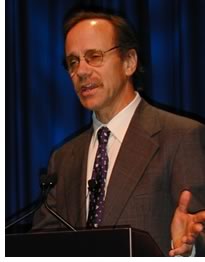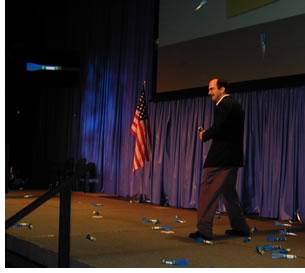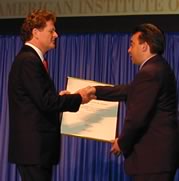

Friday Session Explores Proof that Design Matters
The Friday morning general session found AIA national convention participants, moving from the “poetry” to the “proof” part of architecture, “the less familiar territory,” said AIA President Thompson E. Penney, FAIA, who opened the session. “If we can prove to our clients and the public that design matters . . . design excellence will not be an option, it will be required,” Penney explained. He introduced the mornings “guides” to the territory, Fred Gage, PhD, professor of genetics at The Salk Institute, and Thomas Kelley, general manager of IDEO, the renowned industrial design and development firm, who offered tantalizingly disparate clues into the “proof that design matters.”
Gage: Research could explain intuition
Representing McGraw-Hill Construction, sponsor of the convention theme
presentations, Norbert Young, FAIA, introduced Gage as the person most
qualified to explain the complex link between the environment and life-long
mental development. Within the last two years, Young said, Gage has been
at the forefront of the revelation that the brain continues to grow physically
as we age.
 When
talking about the brain, with it 100 billion neurons and 100 trillion
connections, a popular analogy is to liken it to a computer. The problem
with that, Gage explained, is that it’s wrong. The brain is an organ
and, like any other organ, it changes. Neuroscientists had long believed
that the primary development of the brain ended during early childhood.
More recent findings are that the brain is indeed formed based on the
blueprint of an individual’s DNA, yet it is not fixed and immutable.
The brain actually changes physically though interaction with the environment.
When
talking about the brain, with it 100 billion neurons and 100 trillion
connections, a popular analogy is to liken it to a computer. The problem
with that, Gage explained, is that it’s wrong. The brain is an organ
and, like any other organ, it changes. Neuroscientists had long believed
that the primary development of the brain ended during early childhood.
More recent findings are that the brain is indeed formed based on the
blueprint of an individual’s DNA, yet it is not fixed and immutable.
The brain actually changes physically though interaction with the environment.
Throughout life, stem cells generate neurons in all mammals within certain locations of the brain, such as the hippocampus, where new information comes into the cortex, Gage explained. The production of stem cells in these “dividing-cell” locations is, in turn, affected by how engaging the environment is. An enriched environment can cause the generation of 50 percent more neurons than a non-enriched environment, he said.
Change the environment, change the brain, change our behavior, Gage concluded. “It’s time we worked together to understand how we can live in even better, more beautiful, and effective environments,” he said as a call for architects to continue support of neuroscience research. The research will be invaluable in explaining what now is accepted as intuitive knowledge. Of course large windows make for more engaging school environments, he mused. But why? We are finally at the point where research can form specific hypotheses, test and refine them, and finally determine what mental workings are behind what we have for so long naively termed “intuition.”
Kelley: Innovation begins with an eye
The man who brought the world the Apple mouse, Polaroid’s I-Zone
camera, and hundreds of other cutting-edge products and services, shared
his thoughts about how “design matters.” Kelley said he believes
that great innovations don’t happen in isolation and that creativity
is a team effort drawing on the experience of team members’ diverse
backgrounds.
 Architects
are kindred spirits in design, Kelley said, and even the business world
is coming to realize that, indeed, “design matters.” What
business people traditionally have been “really in love with, though,
is the power of design to increase their brand value,” not so much
the innovation that architects prize. That’s changing though, according
to Kelley, who insists that in 1,500 meetings with clients over the last
20 years he has seen innovation rise to the top of the client’s
list of what is valuable about design.
Architects
are kindred spirits in design, Kelley said, and even the business world
is coming to realize that, indeed, “design matters.” What
business people traditionally have been “really in love with, though,
is the power of design to increase their brand value,” not so much
the innovation that architects prize. That’s changing though, according
to Kelley, who insists that in 1,500 meetings with clients over the last
20 years he has seen innovation rise to the top of the client’s
list of what is valuable about design.
Kelley invited the audience to “vote” for which among five chapters in his book they wanted him to address. Ballots were cast via IDEO-invented “finger blasters”—rubber-band propelled, soft-tipped rockets—which the audience shot at Kelley, at his invitation, as a way to vote on the topics he would address. The audience chose “innovation begins with an eye” and “space: the final frontier.”
“Innovation begins with an eye” deals with “learning away from the desk,” in other words, designers should get out and experience the constantly changing world for themselves. Don’t rely on clients to be able to articulate what you want, Kelley advised. They may not have the vocabulary to tell you what the problems are in a particular circumstance, or even what they need. “You have to know what problem to solve” in order to design a satisfactory solution, he said.
“Space: the final frontier” in Kelley’s parlance, acknowledges architectural space as a telling expression of a client’s company and beliefs. It’s like the difference between verbal language and body language, he said. If the two conflict, always trust the body language. If a company says one thing and their office space another, the people with whom your clients do business will always “listen to the office space.” Explaining this to clients, he says, can help them move from space as a utilitarian asset to “space as a strategic planning issue.”
Copyright 2003 The American Institute of Architects.
All rights reserved. Home Page ![]()
![]()
 |
||
| San Diego Announces Academy of Neuroscience for Architecture as Legacy Project College of Fellows Awards $100,000 Latrobe Fellowship to Academy of Neuroscience for Architecture
Penney Presented the Whitney M. Young Jr. Award to the Hispanic American Construction Industry Association (HACIA), a 23-year-old business membership organization the mission of which is to promote the participation of its members in public and private construction projects throughout the Chicago area. HACIA Executive Director Rafael Hernandez accepted the award, which honors the late civil rights and urban leader Whitney M. Young Jr., who, in 1968, challenged America’s architects to assume their professional responsibility toward social issues. Young
Architect Awards:
|
||
